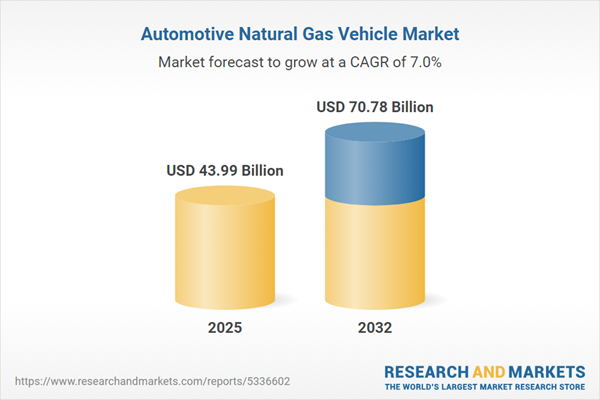Speak directly to the analyst to clarify any post sales queries you may have.
The Automotive Natural Gas Vehicle Market is evolving rapidly as industry stakeholders seek reliable alternatives to traditional fuels. Environmental regulations, operational requirements, and growing infrastructure are shaping adoption strategies among OEMs, fleet operators, and policymakers alike.
Market Snapshot: Automotive Natural Gas Vehicle Market Overview
The Automotive Natural Gas Vehicle Market grew from USD 41.09 billion in 2024 to USD 43.99 billion in 2025. It is expected to continue growing at a CAGR of 7.03%, reaching USD 70.78 billion by 2032.
Scope & Segmentation
This report offers comprehensive analysis and actionable forecasts for strategic planning. Segmentation addresses the full competitive and operational context:
- Fuel Type: Compressed Natural Gas, Liquefied Natural Gas
- Propulsion: Bi-Fuel, Dedicated
- Tank Type: Type I, Type II, Type III, Type IV
- Vehicle Type: Commercial Vehicle, Heavy Commercial Vehicle, Light Commercial Vehicle, Passenger Vehicle
- Application: Off Road, Agriculture, Mining, On Road
- Conversion Type: Aftermarket Conversions, OEM-Fitted NGVs
- Regional Coverage: Americas (North America, United States, Canada, Mexico, Latin America, Brazil, Argentina, Chile, Colombia, Peru), Europe, Middle East & Africa (Europe, United Kingdom, Germany, France, Russia, Italy, Spain, Netherlands, Sweden, Poland, Switzerland, Middle East, United Arab Emirates, Saudi Arabia, Qatar, Turkey, Israel, Africa, South Africa, Nigeria, Egypt, Kenya), Asia-Pacific (China, India, Japan, Australia, South Korea, Indonesia, Thailand, Malaysia, Singapore, Taiwan)
- Company Analysis: Stellantis N.V., Volkswagen AG, Iveco Group N.V., Ford Motor Company, Toyota Motor Corporation, Hyundai Motor Company, General Motors Company, Honda Motor Co., Ltd., Scania AB, AB Volvo
Key Takeaways for Automotive Natural Gas Vehicle Market Decision-Makers
- The market is benefiting from a global momentum toward lower emissions in transportation, supported by policy and regulatory action.
- Engine advancements and the adoption of lightweight composite tanks are enhancing both range and efficiency, addressing enduring challenges around payload and cost.
- OEMs and aftermarket players are driving innovation through modular vehicle platforms, offering both dedicated and dual-fuel flexibility to diverse fleet operators.
- Emerging use cases include urban transit, refuse collection, logistics, agriculture, and mining, broadening the real-world application of natural gas vehicles.
- Collaboration among automakers, infrastructure providers, and technology firms is accelerating the rollout of fueling networks and advanced diagnostic services.
Tariff Impact: Navigating 2025 U.S. Legislative Shifts
Forthcoming United States tariffs on key natural gas vehicle components are influencing operational strategies and cost structures for both OEMs and aftermarket conversion specialists. Suppliers are actively re-evaluating sourcing and domestic production, while fleet operators are reassessing total cost of ownership in light of these policy changes. Strategic moves such as local fabrication partnerships, supply chain re-alignment, and product standardization are being prioritized to maintain competitiveness.
Automotive Natural Gas Vehicle Market: Methodology & Data Sources
The findings are based on a blend of primary interviews with industry engineers, fleet managers, and policymakers, complemented by secondary data from regulatory filings, industry publications, and proprietary sources. Data triangulation, peer validation, and statistical consistency reviews underpin all forecasts and segmentation frameworks.
Why This Report Matters
- Delivers actionable insights for scenario planning in the face of regulatory, supply chain, and technology shifts.
- Provides granular segmentation, enabling precise alignment of product, procurement, and investment strategies.
- Supports decision-makers in evaluating partnership and localization opportunities to secure market advantage.
Conclusion
The Automotive Natural Gas Vehicle Market is dynamic, supported by innovation and evolving policy frameworks. Stakeholders who leverage segment insights and anticipate regulatory impacts will strengthen their position in an increasingly competitive global landscape.
Additional Product Information:
- Purchase of this report includes 1 year online access with quarterly updates.
- This report can be updated on request. Please contact our Customer Experience team using the Ask a Question widget on our website.
Table of Contents
3. Executive Summary
4. Market Overview
7. Cumulative Impact of Artificial Intelligence 2025
Companies Mentioned
The companies profiled in this Automotive Natural Gas Vehicle market report include:- Stellantis N.V.
- Volkswagen AG
- Iveco Group N.V.
- Ford Motor Company
- Toyota Motor Corporation
- Hyundai Motor Company
- General Motors Company
- Honda Motor Co., Ltd.
- Scania AB
- AB Volvo
Table Information
| Report Attribute | Details |
|---|---|
| No. of Pages | 196 |
| Published | October 2025 |
| Forecast Period | 2025 - 2032 |
| Estimated Market Value ( USD | $ 43.99 Billion |
| Forecasted Market Value ( USD | $ 70.78 Billion |
| Compound Annual Growth Rate | 7.0% |
| Regions Covered | Global |
| No. of Companies Mentioned | 11 |









